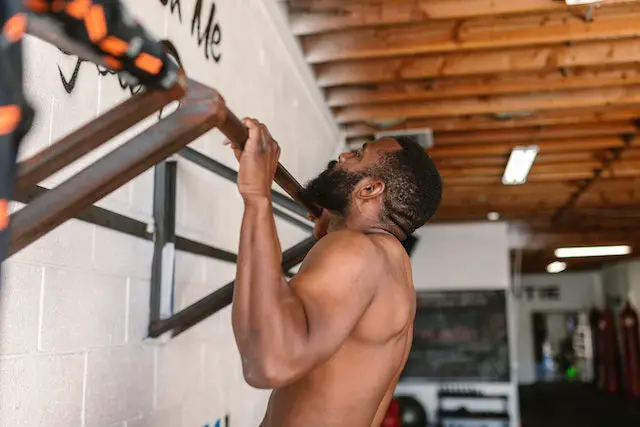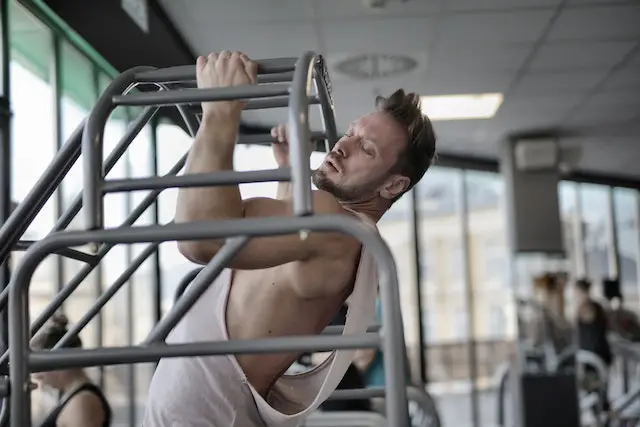This is a big subject. I can think of at least 30 pull up variations and gripping the bar is part of each and every one of them. Let’s break it down.
The Basics of a Pull Up
Let’s first look at the pull up. It is basically flexion of the elbow (meaning your elbow bends) and flexion of the shoulder (meaning your upper arm moves down). Not much else is working aside from your hands holding onto the bar. Everything else could, theoretically, be perfectly relaxed.
If you wanted to get more detailed, I could bring up a slight rotation of the shoulder and the movement of your shoulder blades as well. But the first two movements are enough to get the basics.
Muscles Worked in a Pull Up
The key muscles worked are your latissimus dorsi, trapezius, biceps brachii and brachioradialis.
Here’s a simple video showing those muscles at work:
Types of Pull Up Grips
There are three main variations: Palms toward you, palms away from you, and palms facing each other.
You can add further variation by having a close grip, wide grip, or somewhere in the middle.
Then you can go even further with the variations and build a machine with bars that come off at 45 degrees and that are slightly tilted down and up and sideways and backwards…
But let’s just keep it simple and go over the basics here.
Pull Ups With Your Palms Out

Any time you do pull ups with your palms out, you activate the brachioradialis and your latissimus dorsi muscles to a big degree. This grip uses much less of your biceps brachii than a palms-in grip.
Rock climbers always have very well-developed brachioradialis muscles because their hands are constantly facing away from them when climbing up the side of a cliff.
If you’re new to doing pull ups or if you’ve been training with your palms in, don’t expect to be able to do as many with this grip position.
Pull Ups With Your Palms In

Palms-in pull ups work your biceps the best. It has been the most common way of training pull ups, mainly because people can use a lot of biceps. These are more developed in your average person as opposed to the latissimus dorsi.
Pull Ups With Your Palms Facing Each Other

You may need a special pull up bar to do pull ups with your hands facing each other.
This type of grip is often praised as the most “natural” way to do pull ups, since you’re not twisting your forearm forwards or backwards. It is sometimes referred to as a “neutral” grip.
It tends to work an equal amount of biceps and brachioradialis. Neither one is emphasized with this grip.
This is one variation that is usually done with a close grip – meaning that your hands aren’t super far apart. Rarely is it done with a wide grip.
The Benefits of Close-Grip Pull Ups
Close-grip pull ups (palms in or out) require you to bend your elbow more than you would in a wide or normal grip.
This makes the muscles of your elbow (biceps/brachioradialis) work more than the muscles of your shoulder. Whether your palms are facing away from you, towards you, or are facing each other, the stress on this movement is on those muscles and less on your latissimus dorsi.
The Benefits of Wide-Grip Pull Ups
Now, wide-grip pull ups are generally done with your palms out because twisting your palms in at that angle creates some safety issues.
Wide-grip pull ups work your latissimus dorsi more than the muscles that cross your elbow. And because your palms are facing away from you, this is very heavy on the brachioradialis muscle.
While this may use some of your biceps, it isn’t a primary way to train your biceps.
How To Develop Grip Strength for Pull Ups
There are several factors involved in taking someone from zero pull ups to doing several in a row and then even doing weighted pull ups.
The first thing I do with my clients is have them hang from a bar. If they can only hang for a few seconds, I have them hang with their feet on the floor so that only a percentage of their body is pulling on their hands.
You must be able to hang from a bar if you want to be good at pull ups.
Also, if you’re taking a person from not working out at all, there is another thing that needs to be handled: skin sensitivity. That’s right. Putting the weight of your body on your hands can actually be painful.
If you’re not used to working out, holding dumbbells and especially hanging, then you’ll need to slowly work yourself into this. It is simply part of the process: deadening the nerves in your palm so that it doesn’t hurt so darn much.
I don’t have any special trick to developing grip strength other than the simple act of hanging from a bar. It is the best way to go. Install one in your doorway at home and hang for half a minute at a time.
You’ll get to where hanging is easy.
Should I Use Chalk When I Do Pull Ups for Added Grip?
Chalk will help you hold on to the bar when your forearm strength fails you.
I only use chalk if I am going for a personal record on a deadlift and I want that extra, tiny little bit of friction. Or if I am in a competition with someone to see who can do the most pull ups.
It shouldn’t, in any way, shape or form, be a part of your regular training plan.
If you are in the gym to work your muscles, then work them. Train your grip to failure every day and make it more than strong enough to do the pull ups you need to do.
Conclusion
The pull up can be varied in so many ways that it is hard to list out.
You can do it with added weight (such as a weight vest) and you can have any variation of grips. You can do it with your legs held straight in front of you for extra ab work. The list goes on and on.
Work with a qualified trainer to see what variation would be best for you and pay them to assess you and work out a small program that you can do to get started. It is money well spent.
Many of them would even do it for free.



